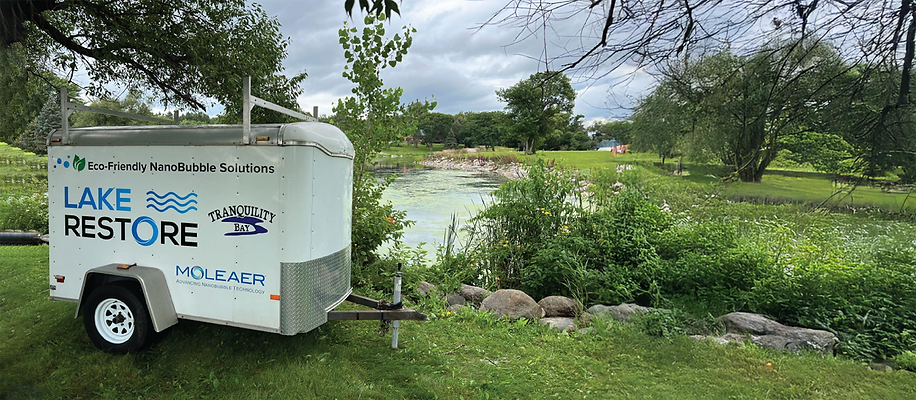How to Get Rid of Pond Muck
- Chad Woolson
- Mar 6, 2024
- 6 min read
Introduction
Pond muck, an accumulation often seen at the bottom of ponds, can be a nuisance for pond owners and enthusiasts. This layer consists primarily of organic materials such as dead plants, fish waste, and other detritus. Understanding the composition and common causes of pond muck is crucial for maintaining not only the ecological balance of your pond but also its aesthetic appeal. A healthy pond contributes to the overall well-being of its aquatic life and enhances the enjoyment it provides to its owners.
Understanding Pond Muck
Pond muck is essentially a natural byproduct of a pond ecosystem's life cycle. It is composed of a variety of organic materials, including dead leaves, decaying plant matter, excess fish food, fish waste, and other organic debris that sinks to the bottom. Over time, these materials break down through the process of decomposition, contributing to the muck layer. While a small amount of muck can be beneficial, acting as a food source for certain microorganisms, excessive accumulation can lead to problems.
How Muck Accumulates
Several factors contribute to the accumulation of pond muck. One primary cause is the overfeeding of fish; uneaten fish food decays and adds to the muck. Similarly, lack of proper aeration in the pond can slow down the decomposition process, allowing organic materials to accumulate faster than they break down. Additionally, natural processes, such as leaves and branches falling into the pond, contribute to the buildup of organic material. Lastly, inadequate filtration and infrequent cleaning practices can exacerbate the situation, leading to a thick layer of muck that can harm the pond's health and appearance.
Maintaining a Clean Pond
Maintaining a clean pond is essential not only for the aesthetic pleasure it provides but also for ensuring a balanced aquatic ecosystem. Excessive muck can deplete the water's oxygen levels, harming fish and beneficial bacteria. Moreover, it can be a breeding ground for pests and harmful pathogens. Addressing the causes of muck buildup and employing strategies for its removal are vital steps in pond management.
Ignoring Pond Muck
Ignoring pond muck can have several negative consequences for both water quality and pond life. Not addressing the buildup of organic debris can degrade the water's clarity and quality, potentially harming the aquatic ecosystem. This environment may struggle to support fish, plants, and beneficial microorganisms. Furthermore, excess muck often leads to unpleasant odors, detracting from the pond's natural beauty and making it an unwelcome feature in any setting. Additionally, the excessive organic material can fuel algae blooms, which not only look unsightly but can also further reduce oxygen levels in the water, creating a vicious cycle that exacerbates the problem. Managing muck is essential to prevent these outcomes and maintain a healthy, vibrant pond. It is essential to rid your pond of muck before the problem escalates.
How to Remove Muck From Your Pond
To effectively manage and remove pond muck, a combination of physical, biological, aeration, and chemical methods can be employed. Each approach offers unique benefits and can be tailored to the specific needs of your pond.
Physical Removal
Physical Removal is the most direct method, involving manual dredging, scooping, or the use of pond vacuums and muck rakes. This hands-on strategy is effective for immediate results, particularly in smaller ponds or specific areas with heavy muck accumulation. However, it can be labor-intensive and may not address the underlying causes of muck formation.
Nanobubble Generator
Nanobubble generators are innovative devices designed to enhance water quality in ponds and lakes by producing extremely small bubbles, smaller than the width of a human hair. These bubbles provide continuous oxygenation to the water's ecosystem, significantly boosting the activity of beneficial bacteria that break down organic matter, including pond muck. The high oxygen levels help maintain a healthy, balanced aquatic environment, promoting clearer water and supporting the overall well-being of aquatic life. Nanobubble technology is recognized for its efficiency and environmental benefits, offering a sustainable solution for water treatment without introducing harmful chemicals.
Biological Treatments
Biological treatments leverage the power of beneficial bacteria and enzymes to naturally break down organic matter, converting it into harmless substances. These treatments enhance the decomposition process, gradually reducing muck levels without harming aquatic life. They are especially beneficial for maintaining long-term pond health and balance but require time to see significant results.
Aeration Solutions
Aeration Solutions play a crucial role in preventing muck accumulation by increasing oxygen levels throughout the pond. Enhanced oxygenation supports the growth of aerobic bacteria, which efficiently decompose organic materials. Options include surface aerators, which agitate water at the pond's surface, and diffused aerators, which release air from the bottom of the pond. Aeration not only helps reduce existing muck but also prevents its future buildup.
Chemical Treatments
Chemical Treatments, such as algaecides and herbicides, offer a targeted approach to controlling algae blooms and invasive plants that contribute to muck. While effective, these treatments should be used judiciously and in accordance with safety guidelines to avoid harming non-target aquatic plants and animals. Understanding the limitations and precautions of chemical treatments is essential to ensure they are part of a comprehensive pond management plan.
Why Nanobubble Generators are the Right Way to Clean Your Muck in Your Pond
Nanobubble generators are an innovative solution for pond muck removal, offering a non-intrusive and efficient method to enhance water quality and clarity. These systems produce incredibly small bubbles that provide continuous oxygenation to the pond's ecosystem. This increased oxygen level boosts the activity of beneficial bacteria that naturally break down organic matter, including muck. Moreover, nanobubbles can remain suspended in water for extended periods, ensuring thorough distribution and effectiveness. Their ability to improve water conditions, coupled with their environmental friendliness, makes nanobubble generators a superior choice for maintaining clean and healthy ponds. Nanobubbles are the most effective way to rid your pond of muck.
Choosing the Right NanoBubble Generator
Choosing the right nanobubble generator depends on your specific needs, ranging from the volume of water you need to treat, energy efficiency, to the specific features that will make your operation more effective. Let's explore the options:
With a flow rate of 40 GPM and energy consumption between 1 - 3.2 KW, the Kingfisher is ideal for smaller applications that require efficiency and simplicity. Its standard 120V outlet compatibility and micro-dose ozone gas injection method make it a straightforward choice for operations looking to implement nanobubble technology with minimal setup.
The Clear 150 steps up the game with a 150 GPM flow rate and similar energy consumption to the Kingfisher. Its small footprint and the ability to operate on compressed air make it versatile for various applications. The option to adjust gas flow up to 30 SCFH allows for tailored solutions, making it a great choice for those needing a bit more power without a significant increase in size or complexity.
NEO offers flexibility with a flow rate ranging from 40 to 275 GPM and energy consumption between 1.1 - 4 KW. Its shore-mounted design, onboard DO sensor, and DO monitoring capabilities cater to users who prioritize precise oxygen level control. The compressed air or concentrated oxygen gas injection options, along with an onboard oxygen concentrator, provide a customizable solution for a wide range of applications.
For large-scale operations, the Titan stands out with its impressive 500 - 5,000 GPM flow rate and variable energy consumption. Its high capacity, custom build options, and ability to inject compressed air or oxygen cater to the most demanding applications. The Titan's onboard oxygen concentrator and DO monitoring capabilities make it the ultimate choice for users requiring maximum efficiency and control over large volumes of water.
Each of these nanobubble generators has its unique advantages. The Kingfisher and Clear 150 are excellent choices for smaller to medium applications, offering simplicity and efficiency. The NEO provides flexibility and precise control for a wide range of applications, while the Titan is unmatched for large-scale operations requiring the highest capacity and customization. Your choice should align with your specific needs, considering factors like flow rate, energy consumption, and the specific features that will benefit your operation the most.
Diy Vs. Professional Help
Deciding between a DIY approach and seeking professional help for pond muck removal depends on the scale and complexity of the issue. For minor muck problems, DIY methods like manual scooping, using pond vacuums, and applying biological treatments can be effective. These are cost-effective and suitable for smaller ponds or when the muck layer isn't too thick.
However, when facing muck accumulation, access to specialized equipment, or a large-scale pond, professional services become necessary. Professionals offer comprehensive management, including advanced biological, aeration, and dredging techniques, ensuring a thorough cleanup that addresses both symptoms and underlying causes. They can also provide ongoing maintenance plans to prevent future muck buildup. Ultimately, evaluating the extent of the problem and considering long-term pond health are crucial in making this decision.
How To Get Rid of Pond Muck
In conclusion, effectively managing and eliminating pond muck is essential for maintaining a healthy pond environment. By utilizing methods such as physical removal, biological treatments, aeration solutions, and, when necessary, chemical treatments, pond owners can significantly reduce muck accumulation. Additionally, the innovative use of nanobubble generators presents a promising approach to enhancing water quality and clarity. It's important for pond owners to assess their situation and consider a combination of these strategies to address both the symptoms and underlying causes of muck buildup. Taking proactive steps towards pond maintenance not only ensures a vibrant and aesthetically pleasing water feature but also contributes to the overall ecological balance. Encouragement to take action and seek professional advice when needed can lead to a healthier, more enjoyable pond environment.
To learn more about










コメント